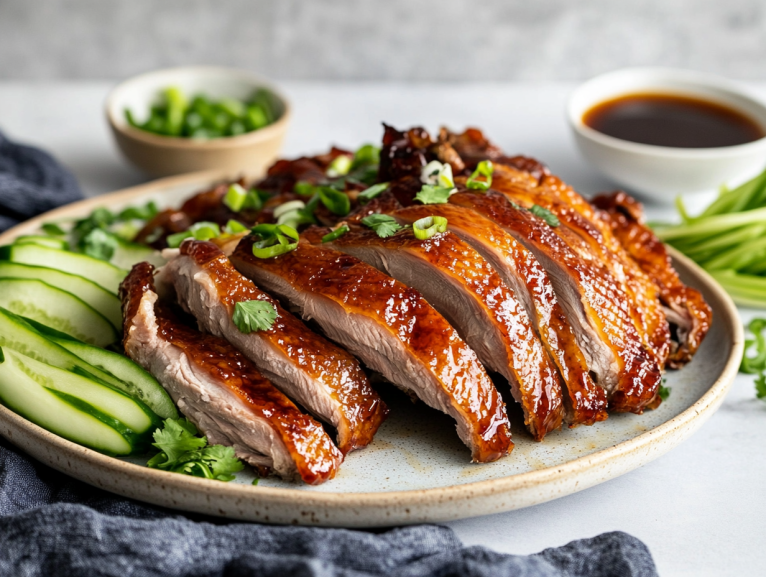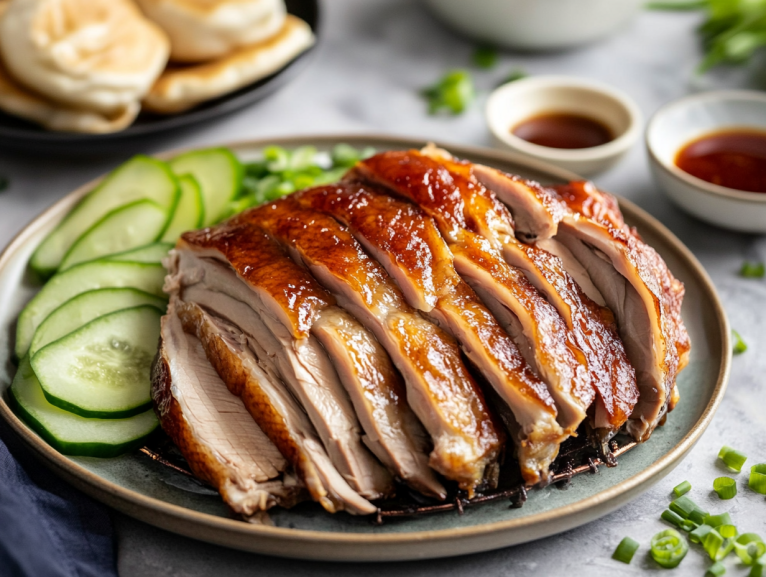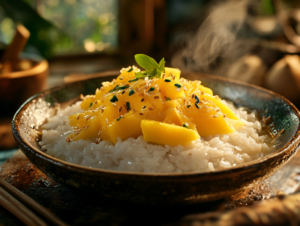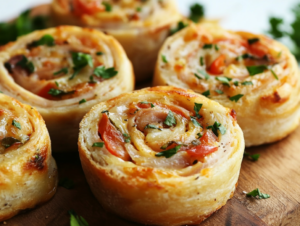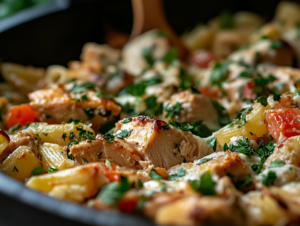Peking Duck is one of the most famous dishes in Chinese cuisine, loved for its crispy skin, succulent meat, and delightful combination of flavors. Traditionally served with thin pancakes, hoisin sauce, and fresh vegetables, this dish has a rich history dating back to the imperial courts of China. If you’ve ever wanted to recreate an authentic Peking Duck at home, this detailed guide will walk you through each step.
Recipe Overview
- Preparation Time: 24 hours (includes marinating and drying time)
- Cooking Time: 1 hour 30 minutes
- Total Time: 25 hours 30 minutes
- Servings: 4
Ingredients
For the Duck:
- 1 whole duck (about 5 pounds), cleaned and patted dry
- 1 tablespoon Chinese five-spice powder
- 2 tablespoons soy sauce
- 2 tablespoons Shaoxing wine (or dry sherry)
- 3 tablespoons honey
- 1 tablespoon maltose (or additional honey)
- 1 teaspoon salt
- 8 cups boiling water
For Serving:
- Mandarin pancakes or steamed buns
- Hoisin sauce
- Fresh cucumber, cut into thin strips
- Scallions, sliced into thin strips
Step-by-Step Instructions
Step 1: Prepare the Duck
- Rinse the duck thoroughly under cold water and pat it dry with paper towels.
- In a small bowl, mix the Chinese five-spice powder and salt. Rub this mixture evenly inside the cavity of the duck.
Step 2: Blanch the Duck
- Bring a large pot of water to a rolling boil. Holding the duck by its neck, carefully pour the boiling water over the entire surface. This step tightens the skin, which is crucial for crispiness.
- Pat the duck dry again and place it on a rack over a baking sheet.
Step 3: Glaze and Dry the Duck
- In a separate bowl, mix together the soy sauce, Shaoxing wine, honey, and maltose until well combined.
- Brush a generous layer of this glaze over the entire surface of the duck.
- Allow the duck to air dry in a cool, well-ventilated area for about 24 hours. Alternatively, place the duck uncovered in the refrigerator overnight.
Step 4: Roast the Duck
- Preheat your oven to 375°F (190°C).
- Place the duck, breast side up, on a rack in a roasting pan.
- Roast for 1 hour.
- Increase the oven temperature to 425°F (220°C) and continue roasting for another 30 minutes, or until the skin is deep golden brown and crispy.
- Remove from the oven and let the duck rest for 15 minutes before carving.
Step 5: Prepare the Accompaniments
- Warm the Mandarin pancakes or steamed buns according to package instructions.
- Arrange the cucumber and scallion strips on a serving platter.
- Pour the hoisin sauce into a small serving bowl.
Step 6: Serve
- Carve the duck into thin slices, ensuring each piece has a portion of crispy skin.
- To enjoy, spread hoisin sauce onto a pancake or bun, add a few slices of duck, and top with cucumber and scallions. Roll up and savor each bite.
Tips for Success
Choosing the Best Duck: Opt for a fresh, high-quality duck. Air-chilled ducks have drier skin, which enhances crispiness.
The Drying Process Matters: If you live in a humid environment, drying the duck in the refrigerator for 24 hours is an excellent alternative.
Enhancing the Glaze: Consider adding orange zest, ginger, or garlic to the glaze for extra flavor.
Serving Variations: Serve with pickled vegetables or a spicy plum sauce for a unique twist.
Nutritional Information (Per Serving)
- Calories: 680
- Protein: 45g
- Fat: 50g
- Carbohydrates: 10g
- Fiber: 1g
- Sugar: 8g
- Sodium: 1200mg
(Note: Nutritional values are approximate and may vary based on ingredients and portion sizes.)
The History of Peking Duck
Peking Duck dates back to the Yuan Dynasty (1271–1368) and was originally served to Chinese emperors. Over time, it became a beloved dish enjoyed by people worldwide. The key to its perfection lies in its preparation, particularly the air-drying and roasting process, which creates the signature crispy skin and succulent meat.
Best Wine and Side Pairings
Pair your Peking Duck with a dry Riesling or Pinot Noir for a well-balanced flavor contrast or Steamed jasmine rice or sautéed bok choy as side dishes.
Common Mistakes to Avoid
- Skipping the drying process: This step is essential for crispy skin.
- Not blanching the duck: This tightens the skin and helps render excess fat.
- Overcooking or undercooking: Use a meat thermometer to ensure the duck is fully cooked (internal temperature of 165°F/75°C).
- Not resting the duck: Letting the duck rest before carving keeps the meat juicy.
Reheating: Warm in an oven at 350°F (175°C) for 10-15 minutes to maintain crispiness.
Where to Buy Authentic Ingredients
To achieve authentic flavor, source high-quality ingredients from:
Asian grocery stores: Look for Shaoxing wine, maltose, and Mandarin pancakes.
Online retailers: Many specialty stores offer these ingredients for delivery.
Local butchers: Some butchers carry fresh, high-quality duck upon request.
Peking Duck vs. Roast Duck: What’s the Difference?
Peking Duck focuses on crispy skin, often served with pancakes, however Cantonese Roast Duck is marinated for a longer time and served with rice or noodles.
Making Peking Duck Without an Oven
If you don’t have an oven, you can use an air fryer at 375°F (190°C) for 45-50 minutes, flipping halfway or Cook on a stovetop with a large wok and lid, basting frequently.
The Science Behind the Crispy Skin
One of the most defining features of Peking Duck is its ultra-crispy skin, achieved through a meticulous cooking process. The secret lies in three critical steps: blanching, air-drying, and roasting at varying temperatures.
- Blanching the Duck: This step tightens the skin and helps render excess fat, ensuring a thin and crispy exterior. The hot water causes the skin to slightly shrink and form a firmer surface for the glaze to adhere to.
- Air-Drying for 24 Hours: Allowing the duck to air-dry overnight is a crucial step. The drying process reduces moisture, which prevents steaming during roasting and helps develop that signature crispy texture. Some chefs even use a small fan to speed up this process.
- Roasting at Dual Temperatures: Peking Duck is typically roasted in two phases—first at a lower temperature to cook the meat thoroughly, then at a higher temperature to crisp up the skin because This method ensures the meat remains juicy while the skin reaches a beautiful golden-brown crunch.
If you want an extra-crispy skin, consider using a specialized duck roaster or hanging the duck vertically in your oven, which mimics the traditional Chinese roasting method.
Traditional vs. Modern Cooking Techniques
Authentic Peking Duck has been prepared using time-honored techniques for centuries, but modern home cooks have adapted the recipe for convenience. Here’s how traditional and modern methods compare:
| Method | Traditional Approach | Modern Home Cooking |
|---|---|---|
| Blanching | Dipped into boiling water in large woks | Poured over with boiling water in a sink or roasting pan |
| Drying | Hung in well-ventilated spaces or near open-air fans | Dried in a refrigerator overnight |
| Roasting | Hung in a specialized duck oven over an open flame | Placed on a rack in a home oven |
| Glazing | Painted with a maltose-based syrup | Brushed with a honey-based mixture |
While traditional methods may not always be practical at home, you can still achieve incredible results by following the drying and roasting techniques mentioned earlier. If you have a rotisserie oven, consider using it to mimic the movement of hanging ducks in traditional roasting setups.
How Peking Duck is Served in Restaurants
If you’ve ever ordered Peking Duck at a restaurant, you’ve likely noticed the meticulous way it’s served. The dish is often presented in multiple courses, each highlighting a different aspect of the duck:
- Crispy Skin First: Many high-end restaurants serve the crispy skin separately before the meat. It’s often dipped in sugar or a light sauce to enhance its rich, caramelized flavor.
- Main Dish – Duck Pancakes: Thinly sliced duck meat, complete with crispy skin, is placed on Mandarin pancakes or steamed buns, topped with hoisin sauce, scallions, and cucumber.
- Second Course – Duck Soup or Stir-Fried Duck: After the main course, some restaurants use the leftover duck bones to prepare a flavorful soup or stir-fry the remaining meat with vegetables.
If you’re hosting a dinner party and want to impress your guests you should consider serving Peking Duck in these multiple courses to give them an authentic restaurant-style experience.
Making Peking Duck at home may seem like a challenge, but the results are well worth the effort. With the right technique, you can achieve a restaurant-quality dish that will impress your guests and satisfy your cravings for authentic Chinese cuisine.
Give this recipe a try and enjoy a taste of China in your own kitchen!
Print
Authentic Peking Duck Recipe: A Step-by-Step Guide to Perfection
Description
For the Duck:
- 1 whole duck (about 5 pounds), cleaned and patted dry
- 1 tablespoon Chinese five-spice powder
- 2 tablespoons soy sauce
- 2 tablespoons Shaoxing wine (or dry sherry)
- 3 tablespoons honey
- 1 tablespoon maltose (or additional honey)
- 1 teaspoon salt
- 8 cups boiling water
For Serving:
- Mandarin pancakes or steamed buns
- Hoisin sauce
- Fresh cucumber, cut into thin strips
- Scallions, sliced into thin strips
Ingredients
Step 1: Prepare the Duck
- Rinse the duck thoroughly under cold water and pat it dry with paper towels.
- In a small bowl, mix the Chinese five-spice powder and salt. Rub this mixture evenly inside the cavity of the duck.
Step 2: Blanch the Duck
- Bring a large pot of water to a rolling boil. Holding the duck by its neck, carefully pour the boiling water over the entire surface. This step tightens the skin, which is crucial for crispiness.
- Pat the duck dry again and place it on a rack over a baking sheet.
Step 3: Glaze and Dry the Duck
- In a separate bowl, mix together the soy sauce, Shaoxing wine, honey, and maltose until well combined.
- Brush a generous layer of this glaze over the entire surface of the duck.
- Allow the duck to air dry in a cool, well-ventilated area for about 24 hours. Alternatively, place the duck uncovered in the refrigerator overnight.
Step 4: Roast the Duck
- Preheat your oven to 375°F (190°C).
- Place the duck, breast side up, on a rack in a roasting pan.
- Roast for 1 hour.
- Increase the oven temperature to 425°F (220°C) and continue roasting for another 30 minutes, or until the skin is deep golden brown and crispy.
- Remove from the oven and let the duck rest for 15 minutes before carving.
Step 5: Prepare the Accompaniments
- Warm the Mandarin pancakes or steamed buns according to package instructions.
- Arrange the cucumber and scallion strips on a serving platter.
- Pour the hoisin sauce into a small serving bowl.
Step 6: Serve
- Carve the duck into thin slices, ensuring each piece has a portion of crispy skin.
- To enjoy, spread hoisin sauce onto a pancake or bun, add a few slices of duck, and top with cucumber and scallions. Roll up and savor each bite.

